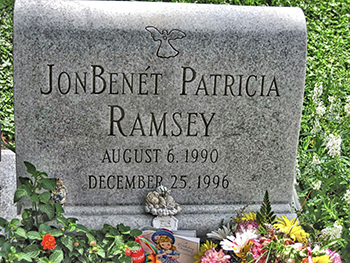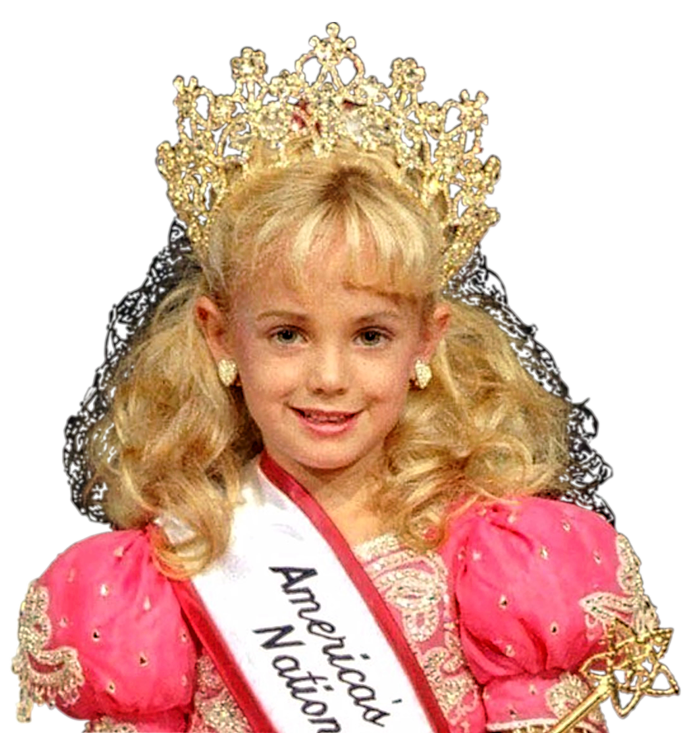

JonBenét Patricia Ramsey (August 6, 1990 – December 25, 1996) was a child beauty pageant queen who was murdered in her home in Boulder, Colorado, in 1996. Her body was discovered in the basement of the family home roughly eight hours after she was first reported missing during a police search of her home. An unknown assailant bludgeoned and strangled her.
Colorado law enforcement first suspected JonBenét's parents – John Bennett Ramsey and his wife Patricia "Patsy" Ramsey – as well as her brother, Burke. The family was partially absolved in 2003 when DNA evidence from JonBenét's clothes indicated they were not involved. Five years later, in July 2008, the Ramseys were cleared by state investigators. But then in February 2009, the Boulder Police Department took back the case and reopened it.
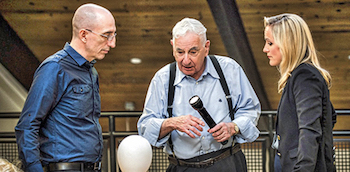
From the beginning, media coverage focused on JonBenét's participation in child beauty pageants, her parents' affluent lifestyle, and the unusual evidence surrounding the crime. The police's handling of the case has also been criticized. Members of the Ramsey family and family friends have filed defamation suits against media organizations for their coverage of the murder.
JonBenét Ramsey was born in Atlanta, Georgia, on August 6, 1990. When she was nine months old the family moved to Boulder, Colorado. In just a few short years she began to be enrolled by her mother in beauty pageants. Some of them were funded by Patsy Ramsey herself. Her active (sometimes central) role in them has been highly scrutinized and criticized by the media and onlookers.
In court, Patsy Ramsey testified that she first realized her daughter was missing on the morning of December 26, 1996, after finding, on the kitchen staircase, a two-and-a-half-page ransom letter demanding $118,000 for the girl's safe return. The dollar figure is nearly the exact value of a cash bonus her husband had received on the job earlier that year. Despite specific instructions to the contrary in the note, Patsy called the police, family and friends.
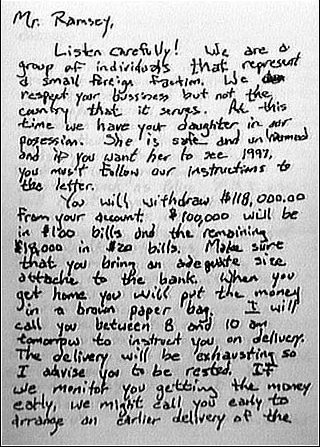
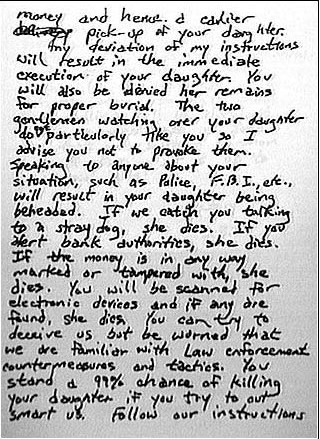
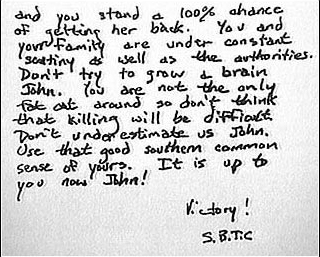
The text of the ransom note:
Mr. Ramsey,
Listen Carefully! We are a group of individuals that represent a small foreign faction. We respect your business, but not the country it serves. At this time, we have your daughter in our possession. She is safe and unharmed and if you want her to see 1997, you must follow our instructions to the letter.
You will withdraw $118,000 from your account. $100,000 will be in $100 bills and the remaining $18,000 in $20 bills. Make sure that you bring an adequate size attache to the bank. When you get home, you will put the money in a brown paper bag. I will call you between 8 and 10 a.m. tomorrow to instruct you on delivery. The delivery will be exhausting so I advise you to be rested. If we monitor you getting the money early we might call you early to arrange an earlier delivery of the money and hence and earlier pickup of your daughter.
Any deviation of my instructions will result in the immediate execution of your daughter. You will also be denied her remains for a proper burial. The two gentlemen watching over your daughter do not particularly like you so I advise you not to provoke them. Speaking to anyone about your situation, such as police or F.B.I. will result in your daughter being beheaded. If we catch you talking to a stray dog, she dies. If you alert bank authorities, she dies. If the money is in way marked or tampered with, she dies. You can try to deceive us, but be warned we are familiar with law enforcement countermeasures and tactics. You stand a 99% chance of killing your daughter if you try to outsmart us. Follow our instructions and you stand a 100% of getting her back. You and your family are under constant scrutiny, as well as the authorities. Don't try to grow a brain John. You are not the only fat cat around so don't think that killing will be difficult. Don't underestimate us, John. Use that good, Southern common sense of yours. It's up to you now John!Victory!
S.B.T.C.
The Boulder police conducted a superficial search of the Ramsey house, but found no signs of a break-in. The note specified that the ransom collection would be monitored and JonBenét would be returned safely as soon as the money was transferred. John Ramsey made arrangements with a friend to have the money picked up that morning at a local bank.
That same day in the afternoon, Boulder Police Detective Linda Arndt asked Fleet White, a friend of the Ramseys, to go with John Ramsey and do a search of the house for "anything unusual". John Ramsey and two of his friends started in the basement. After first looking in the bathroom and "train room" and finding nothing, the three of them investigated the "wine cellar" room – there they found John Ramsey's daughter's body, covered in a white blanket. A nylon cord was tied around her neck, her wrists were tied over her head, and her mouth was covered with duct tape.
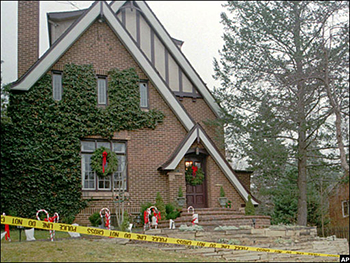
Observers would later claim that police made several critical mistakes in the early hours of the investigation – by not sealing off the crime scene, and allowing friends and family to move without restriction in and out of the house.
Critics of the investigation also faulted officers for lack of vigilance in gathering forensic evidence before or after the discovery of JonBenét's body, perhaps because they already suspected the Ramseys were the culprits. Some officers revealed their suspicions to the local media, which, beginning January 1, began quoting the assistant district attorney as saying that "it's not adding up"; the discovery of JonBenét's body in her own home was seen as highly suspicious by investigators.
According to autopsy findings, JonBenét was killed by strangulation and a skull fracture. A garrote fashioned from tweed cord and the damaged handle of a paintbrush was used to strangle her; her skull had been subjected to severe blunt trauma; there was no evidence of rape, at least in the conventional sense – but sexual assault couldn't be ruled out either.

One end of the paintbrush was found in a tub of Patsy Ramsey's art supplies, but the other end was never located despite thorough searching of the house by law enforcement. Experts said the construction of the garrote pointed to the assailant having a special knowledge of knots. The autopsy also found that JonBenét had eaten pineapple just a few hours before the murder. Photographs of the home, taken that day show a bowl of pineapple on the kitchen table with a spoon in it, and police found JonBenét's nine-year-old brother Burke Ramsey's fingerprints. But Patsy and John claim they had no memory of putting the bowl on the table or of giving pineapple to JonBenét. They have always insisted that Burke was asleep through the entire episode, until he was awakened many hours later by the arrival of police.

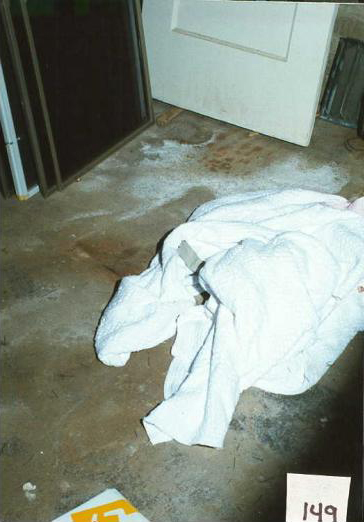
In December 2003, forensic investigators extracted enough material from a blood sample on JonBenét's underwear to establish a DNA profile. It belongs to an unknown male. The DNA was submitted to the FBI's Combined DNA Index System (CODIS), a database consisting of more than 1.6 million DNA profiles, mostly from convicted felons. The sample has yet to register a match in the database, though it continues to be checked weekly for partial matches – standard procedure for all unmatched DNA samples.
Later investigations also revealed there were over 100 burglaries in the Ramseys' neighborhood in the months leading up to JonBenét's murder, as well as 38 registered sex offenders living in a two-mile radius of the Ramsey home - an area encompassing fully half the population of the city of Boulder-but, frustratingly, none of them have been shown to have any involvement in the Ramsey murder.
On August 16, 2006, 41-year-old John Mark Karr, a one-time schoolteacher, confessed to the murder while being held on child pornography charges in Sonoma County, California. Investigators tracked him down on the Internet after he sent e-mails about the Ramsey case to a journalism professor at the University of Colorado. Seized by police in Bangkok, Thailand, he confessed to being with JonBenét when she died, stating that her death was accidental.
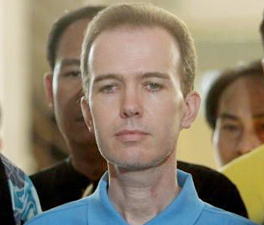
But Karr's DNA did not match the DNA on JonBenét Ramsey's body, and prosecutors filed no charges against him in the case. But in early December 2006, federal investigators were still exploring whether Karr could have been an accomplice in the murder.
No evidence has ever surfaced placing then-married Alabama resident Karr near Boulder. What evidence there is linking him to the crime is highly circumstantial. For instance, handwriting samples taken from Karr are said to match the ransom note.
On July 9, 2008, the Boulder District Attorney's office announced that newly-developed DNA sampling and testing technologies had cleared the Ramseys and they were no longer considered suspects in the case. Boulder County District Attorney Mary Lacy officially tendered a letter of apology to John Ramsey:
This new scientific evidence convinces us... to state that we do not consider your immediate family, including you, your wife, Patsy, and your son, Burke, to be under any suspicion in the commission of this crime.
...The match of Male DNA on two separate items of clothing worn by the victim at the time of the murder makes it clear to us that an unknown male handled these items. There is no innocent explanation for its incriminating presence at three sites on these two different items of clothing that JonBenét was wearing at the time of her murder. ... To the extent that we may have contributed in any way to the public perception that you might have been involved in this crime, I am deeply sorry. No innocent person should have to endure such an extensive trial in the court of public opinion, especially when public officials have not had sufficient evidence to initiate a trial in a court of law. ... We intend in the future to treat you as the victims of this crime, with the sympathy due you because of the horrific loss you suffered...
I am aware that there will be those who will choose to continue to differ with our conclusion. But DNA is very often the most reliable forensic evidence we can hope to find and we rely on it often to bring to justice those who have committed crimes. I am very comfortable that our conclusion that this evidence has vindicated your family is based firmly on all of the evidence.

Media, experts, and parents have been split on the Ramsey case from the beginning. Boulder police were convinced that Patsy Ramsey injured JonBenét in a fit of rage after the girl wet her bed, then killed her while still in that rage or more deliberately, in order to cover up the original injury. Handwriting experts initially pointed the finger at Patsy Ramsey as being the likely author of the ransom note. But it was only a supposition.
Another theory had John Ramsey sexually abusing his daughter and murdering her as a cover. The Ramseys' son Burke, who was nine at the time, was also the focus of speculation – because of this he asked to testify at the grand jury hearing. Then there was Colorado Governor Bill Owens, who publicly chastised the parents, pressuring them to "...quit hiding behind their attorneys, quit hiding behind their PR firm." It's no exaggeration to say that initial police suspicions initially lay solely on the Ramseys, although John and Patsy had never shown signs of aggression toward their daughter prior to the murder.

The Ramseys have consistently maintained that the crime was the work of an intruder. They hired John E. Douglas, former head and founder of the FBI's Behavioral Science Unit, to look into the case. He included his assessment in his 2001 book, The Cases That Haunt Us. Douglas came to believe that the crime was most likely a kidnapping gone horribly wrong – and that the Ramseys were not involved. His arguments:
Douglas acknowledges that a sizable portion of child homicides are committed by parents and family of the victim. He doesn't fault the original investigators for subjecting the Ramsey family to intense scrutiny. Douglas does, however, fault Boulder authorities for what he considers a badly flawed investigation which was further hindered by political infighting and jurisdictional jealousies. In the mid 1990s, Boulder police typically had to investigate just one or two homicides per year, and so had little experience with anything like the Ramsey homicide, with its unique and daunting challenges.
Douglas believes the most likely scenario involves JonBenét dying at the hands of a young and inexperienced criminal (the possible digital penetration of the girl's vagina being consistent, for instance, with a young sex offender spurred by naive curiosity about female anatomy) with a sexual obsession over the child and/or a desire to extort money from a wealthy family. Douglas regards as unlikely the possibility that Patsy wrote the ransom note, arguing that it was probably written before the crime. In Douglas's years of experience, it would be next to impossible for anyone – especially an inexperienced killer – to keep their composure while writing a letter as long and detailed as the Ramsey ransom note.
Lou Smit, a veteran detective who came out of retirement to work with Boulder authorities on the case early in 1997, also suspected the parents at the outset, but after examining the evidence also came to conclude that the perpetrator was an intruder.

A grand jury refused to indict either the Ramseys or anyone else in the murder of JonBenét. Not long afterwards, the parents moved to a new home in Atlanta. Meanwhile two lead investigators in the case resigned, one because he believed the investigation incompetently discounted the intruder hypothesis, the other because he believed it failed to prosecute the Ramseys. Despite this, other investigators continue in the quest to identify a suspect. Patsy Ramsey died of ovarian cancer on June 24, 2006, at the age of 49.
In October 2010, the case was reopened. New interviews were held by a committee made up of state and federal investigators. Police used the very latest DNA technology in their investigative arsenals.
In January of 2013 it was announced that a grand jury had found enough evidence to indict John and Patsy Ramsey on charges of child abuse resulting in death. The District Attorney refused to sign the indictment, however, leaving the inescapable conclusion that the grand jury investigation was, again, inconclusive.
